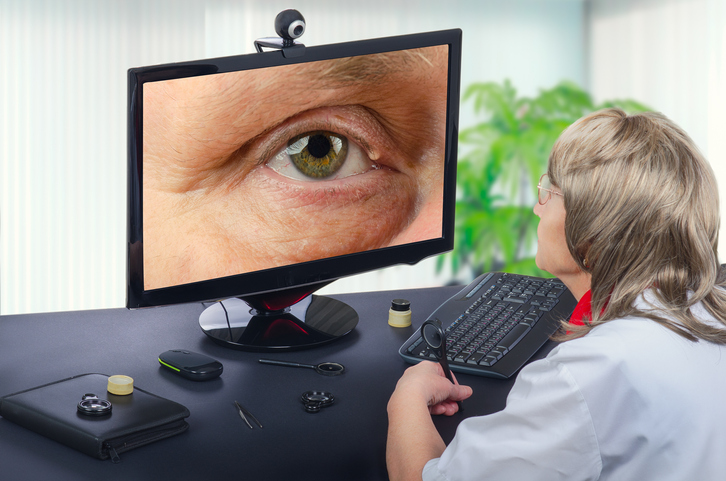At this point, most ophthalmology clinics have cancelled all non-emergency procedures and office visits. As a result, telehealth — which was gaining a bit of notice pre-COVID-19 — is now a main topic of conversation. Traditionally, telehealth hasn’t been that easy to incorporate into ophthalmology, mostly because of the lack of ophthalmic tools.
“There really wasn’t a way of doing VA (visual acuity). Obviously, many of the main practices that center on visual field and OCT can’t be done in telehealth,” said Dr. Rishi P. Singh, associate professor of ophthalmology and staff physician, Cole Eye Institute, Cleveland Clinic, Ohio, U.S., during a webinar entitled “Getting Started with Telehealth for Eye Visits.”
That’s all changing now — and in today’s world, using telehealth platforms might have a significant role in ophthalmology, including education and operation planning.
Best Practices for Telehealth Appointments

According to the United States Center for Medicare Services (CMS), Dr. Singh explained that there are two types of telehealth appointments: synchronous audio and visual visits, and asynchronous telephone/email visits. The first is like a virtual visit, where the physician can either bill based on time or on medical complexity. Meanwhile, the second type includes reviewing images or replying to a patient through email or text, or other portals.
He covered the documentation requirements for these visits. For example, for an audio/video appointment, the patient’s history must be obtained and verified (along with their chief complaint); an exam must be conducted either by asking questions or visual inspection; and an assessment and plan for treatment must be completed.
“They’ve removed the exam requirements, but whatever you can document on the exam, both from visual inspection and the patient telling you, is important to mark on their actual examination component,” shared Dr. Singh. “During the assessment and planning stage, it’s important to note that the visit was conducted virtually.”
He also emphasized adding an attestation phrase regarding the visit, including time spent with the patient. In addition, when billing for these visits, Dr. Singh said: “When billing for time, you must spend the entire allotted time face-to-face with the patient and over half of that time must have been devoted to counseling and/or coordination.”
For the telephone or audio-only visits, he said that the requirements are similar.
“Telehealth visits are obviously different for ophthalmologists and optometrists now — we weren’t necessarily used to using these appointments as our general routine practice before,” said Dr. Singh.
Considerations for Telehealth Appointments

Prior to beginning a telehealth practice, there are a few things to consider: “Will you conduct these visits in your home or office? Will you involve your technician? Also, you have to decide how long you will need for these appointments,” he explained. “A lot of the time, I conduct these in the office during my normal clinic time . . . I mix them in between patients and address them as my schedule allows during the day.”
Because of the patient history that must be covered, Dr. Singh said that he finds that his time for these visits usually goes up by about 50 percent, so it’s important to take that into consideration.
He also said that once a clinic selects a platform for these virtual visits, it’s important to stick to that medium. At his clinic, they use FaceTime and Google Duo because they are Android and iPhone platforms. If the patients don’t have access to either, then they just do a phone visit. To keep your personal phone number private, you can go into your settings and change the number to an email address, noted Dr. Singh.
He said that, of course, there are legal and liability issues to consider: The best practice is to obtain consent and remind the patient that this communication is not the same as a face-to-face exam (with the appropriate legal verbiage). “We write in the chart that the patient initiated the request for care and consented to care by phone,” he explained. “If there is the least bit of uneasiness on my part, or skepticism about their complaint, I’m going to schedule them for an in-office visit.”
Right now, we can’t foresee the end of the pandemic . . . it could go on for months. Therefore, Dr. Singh also recommended considering a hybrid approach to patient visits.
In this case, the patient comes into the office for a brief visit for testing only: “This decreases their time in the office and patient exposure,” said Dr. Singh. The technician conducts the tests (i.e., IOP, VA, OCT, etc.), then the doctor can review at a convenient time and conduct a virtual visit afterward.
Finally, he said that physicians will need to be creative and use different technologies and methods for these virtual visits . . . and as these appointments become more commonplace, future technologies will enhance these remote visits.
Editor’s Note: The Optos Presents “Getting Started with Virtual Visits” webinar was held on April 22, 2020, from 8.00 to 9.00 p.m. (EST).



